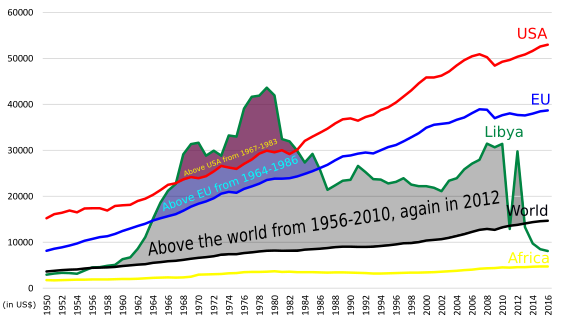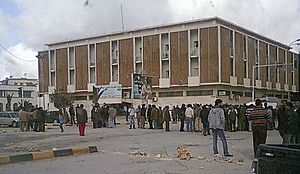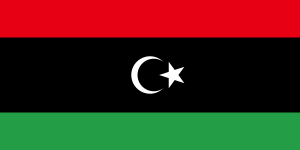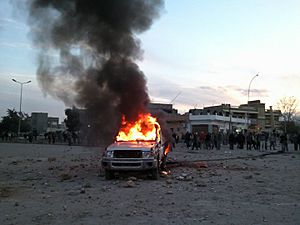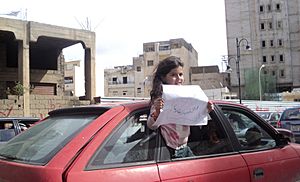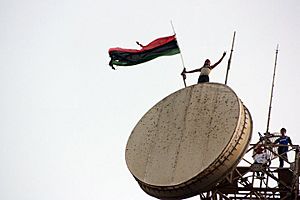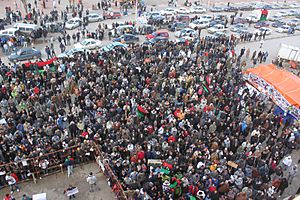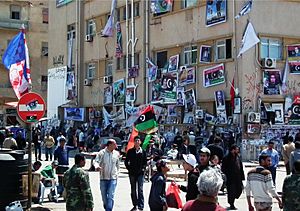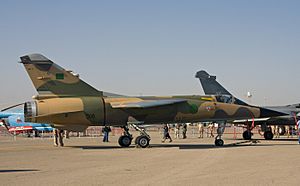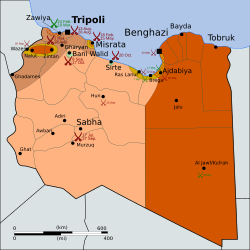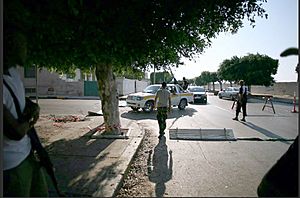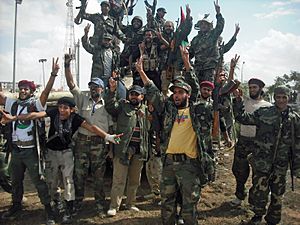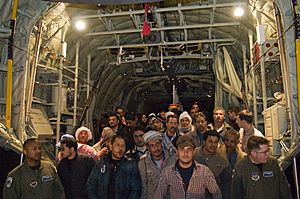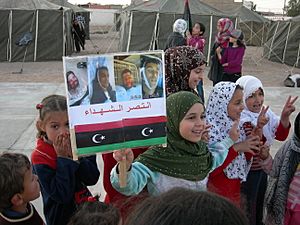First Libyan Civil War facts for kids
Quick facts for kids First Libyan Civil War |
|||||||
|---|---|---|---|---|---|---|---|
| Part of the Arab Spring and the Libyan Crisis | |||||||
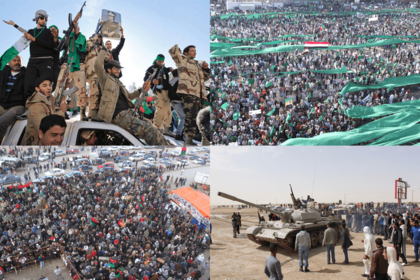 From left to right: Armed pro-government supporters; Pro-government protesters gathered in Green Square, now known as Martyrs' Square; anti-Government protesters in Benghazi; Libyan rebels on a tank. |
|||||||
|
|||||||
| Belligerents | |||||||
|
Enforcing UNSC Resolution 1973: NATO members
Other countries
Minor border clashes: |
|
||||||
| Commanders and leaders | |||||||
|
|
|||||||
| Strength | |||||||
|
200,000 volunteers by war's end International Forces: Numerous air and maritime forces (see here) |
20,000–50,000 soldiers & militiamen | ||||||
| Casualties and losses | |||||||
| 5,904–6,626 killed (other estimates: see here) |
3,309–4,227 soldiers killed (other estimates: see here) 7,000 captured* |
||||||
| Total casualties (including civilians): 9,400–25,000 killed 4,000 missing 50,000 wounded (other estimates: see here) |
|||||||
| *Large number of loyalist or immigrant civilians, not military personnel, among those captured by rebels, only an estimated minimum of 1,692+ confirmed as soldiers | |||||||
The First Libyan Civil War was an armed conflict in 2011 in the North African country of Libya that was fought between forces loyal to Colonel Muammar Gaddafi and rebel groups that were seeking to oust his government. It erupted with the Libyan Revolution, also known as the 17 February Revolution. The war was preceded by protests in Zawiya on 8 August 2009 and finally ignited by protests in Benghazi beginning on Tuesday, 15 February 2011, which led to clashes with security forces who fired on the crowd. The protests escalated into a rebellion that spread across the country, with the forces opposing Gaddafi establishing an interim governing body, the National Transitional Council.
The United Nations Security Council passed an initial resolution on 26 February, freezing the assets of Gaddafi and his inner circle and restricting their travel, and referred the matter to the International Criminal Court for investigation. In early March, Gaddafi's forces rallied, pushed eastwards and re-took several coastal cities before reaching Benghazi. A further UN resolution authorised member states to establish and enforce a no-fly zone over Libya, and to use "all necessary measures" to prevent attacks on civilians, which turned into a bombing campaign by the forces of NATO against Libyan military installations and vehicles. The Gaddafi government then announced a ceasefire, but fighting and bombing continued. Throughout the conflict, rebels rejected government offers of a ceasefire and efforts by the African Union to end the fighting because the plans set forth did not include the removal of Gaddafi.
In August, rebel forces launched an offensive on the government-held coast of Libya, backed by a wide-reaching NATO bombing campaign, taking back territory lost months before and ultimately capturing the capital city of Tripoli, while Gaddafi evaded capture and loyalists engaged in a rearguard campaign. On 16 September 2011, the National Transitional Council was recognised by the United Nations as the legal representative of Libya, replacing the Gaddafi government. Muammar Gaddafi evaded capture until 20 October 2011, when he was captured and killed in Sirte. The National Transitional Council declared "the liberation of Libya" and the official end of the war on 23 October 2011.
In the aftermath of the civil war, a low-level insurgency by former Gaddafi loyalists continued. There were various disagreements and strife between local militias and tribes, including fighting on 23 January 2012 in the former Gaddafi stronghold of Bani Walid, leading to an alternative town council being established and later recognized by the National Transitional Council (NTC). Madkhalism had become influential among many militias, leading to further division. A much greater issue had been the role of militias which fought in the civil war and their role in the new Libya. Some refused to disarm, and cooperation with the NTC had been strained, leading to demonstrations against militias and government action to disband such groups or integrate them into the Libyan military. These unresolved issues led directly to a second civil war in Libya.
Contents
Background
Leadership
Muammar Gaddafi was the head of the Free Officers, a group of Arab nationalists that deposed King Idris I in 1969 in a "bloodless coup". He abolished the Libyan Constitution of 1951, considering it a neocolonial document. From 1969 until 1975 standards of living, life expectancy and literacy grew rapidly. In 1975 he published his manifesto The Green Book. He officially stepped down from power in 1977, and subsequently claimed to be merely a "symbolic figurehead" until 2011, with the Libyan government up until then also denying that he held any power.
Under Gaddafi, Libya was theoretically a decentralized, direct democracy state run according to the philosophy of Gaddafi's The Green Book, with Gaddafi retaining a ceremonial position. Libya was officially run by a system of people's committees which served as local governments for the country's subdivisions, an indirectly elected General People's Congress as the legislature, and the General People's Committee, led by a Secretary-General, as the executive branch. According to the US Government funded Freedom House, however, these structures were often manipulated to ensure the dominance of Gaddafi, who reportedly continued to dominate all aspects of government.
WikiLeaks' disclosure of confidential US diplomatic cables revealed US diplomats there speaking of Gaddafi's "mastery of tactical maneuvering". While placing relatives and loyal members of his tribe in central military and government positions, he skilfully marginalized supporters and rivals, thus maintaining a delicate balance of powers, stability and economic developments. This extended even to his own sons, as he repeatedly changed affections to avoid the rise of a clear successor and rival.
Both Gaddafi and the Libyan Arab Jamahiriya, however, officially denied that he held any power, but said that he was merely a symbolic figurehead. While he was popularly seen as a demagogue in the West, Gaddafi always portrayed himself as a statesman-philosopher.
According to several Western media sources, Gaddafi feared a military coup against his government and deliberately kept Libya's military relatively weak. The Libyan Army consisted of about 50,000 personnel. Its most powerful units were four crack brigades of highly equipped and trained soldiers, composed of members of Gaddafi's tribe or members of other tribes loyal to him. One, the Khamis Brigade, was led by his son Khamis. Local militias and Revolutionary Committees across the country were also kept well-armed. By contrast, regular military units were poorly trained, and were armed with largely outdated military equipment.
Development and corruption
By the end of Gaddafi's 42-year rule, Libya's population had a per capita income of $14,000, though a third was estimated to still live below the national poverty line. A broadly secular society was imposed. Child marriage was banned, and women enjoyed equality of equal pay for equal work, equal rights in divorce and access to higher education rose from 8% in 1966 to 43% in 1996, equal to that of men. Homelessness was insignificant, with literacy rates estimated at 88%, and average life expectancy rose from 51/54 in 1969 to 74/77.
Much of the state's income came from its oil production, which soared in the 1970s. In the 1980s, a large portion of it was spent on arms purchases, and on sponsoring militant groups and independence movements around the world. Libya's economy was structured primarily around the nation's energy sector, which in the 2000s generated about 95% of export earnings, 80% of GDP, and 99% of government income. Libya is a member of OPEC and one of the world's largest oil producers. It was producing roughly 1.6 million barrels a day before the war, nearly 70% of them through the state-owned National Oil Corporation. Additionally, the country's sovereign wealth fund, the Libyan Investment Authority, was one of the largest in the world, controlling assets worth approximately US$56 billion, including over 100 tons of gold reserves in the Central Bank of Libya. Libya's GDP per capita (PPP), human development index, and literacy rate were better than in Egypt and Tunisia, whose Arab Spring revolutions preceded the outbreak of protests in Libya.
Libya's corruption perception index in 2010 was 2.2, ranking 146th out of 178 countries, worse than that of Egypt (ranked 98th) and Tunisia (ranked 59th). One paper speculated that such a situation created a broader contrast between good education, high demand for democracy, and the government's practices (perceived corruption, political system, supply of democracy). An estimated 13% of Libyan citizens were unemployed. More than 16% of families had no members earning a stable income, and 43.3% had just one. Despite one of the highest unemployment rates in the region, there was a consistent labor shortage with over a million migrant workers present on the market. These migrant workers were the bulk of the refugees leaving Libya after the beginning of hostilities. Despite this, Libya's Human Development Index in 2010 was the highest in Africa and greater than that of Saudi Arabia. Libya had welfare systems allowing access to free education, free healthcare, and financial assistance for housing, and the Great Manmade River was built to allow free access to fresh water across large parts of the country.
Some of the worst economic conditions were in the eastern parts of the state, once a breadbasket of the ancient world, where Gaddafi extracted oil. Except for housing improvements and the Great Manmade River, little infrastructure was developed in this region for many years. For example, the only sewage facility in Benghazi was over 40 years old, and untreated sewage has resulted in environmental problems.
Several foreign governments and analysts have stated that a large share of the business enterprise was controlled by Gaddafi, his family, and the government. A leaked US diplomatic cable said that the Libyan economy was "a kleptocracy in which the government – either the Gaddafi family itself or its close political allies – has a direct stake in anything worth buying, selling or owning". According to US officials, Gaddafi amassed a vast personal fortune during his 42-year leadership. The New York Times pointed to Gaddafi's relatives adopting lavish lifestyles, including luxurious homes, Hollywood film investments, and private parties with American pop stars.
Gaddafi said that he planned to combat corruption in the state by proposing reforms where oil profits are handed out directly to the country's five million people rather than to government bodies, stating that "as long as money is administered by a government body, there would be theft and corruption." Gaddafi urged a sweeping reform of the government bureaucracy, suggesting that most of the cabinet system should be dismantled to "free Libyans from red tape" and "protect the state's budget from corruption". According to Western diplomats, this move appeared to be aimed at putting pressure on the government to speed up reforms. In March 2008, Gaddafi proposed plans to dissolve the country's existing administrative structure and disburse oil revenue directly to the people. The plan included abolishing all ministries except those of defence, internal security, and foreign affairs, and departments implementing strategic projects. He stated that the ministries were failing to manage the country's oil revenues, and that his "dream during all these years was to give power and wealth directly to the people".
A national vote on Gaddafi's plan was held in 2009, where Libya's people's congresses, collectively the country's highest authority, voted to delay implementation. The General People's Congress announced that, of 468 Basic People's Congresses, 64 chose immediate implementation while 251 endorsed implementation "but asked for (it) to be delayed until appropriate measures were put in place". Some top government officials opposed the plan, saying that it would "wreak havoc" in the economy by "fanning inflation and spurring capital flight". Gaddafi acknowledged that the scheme, which promised up to 30,000 Libyan dinars ($23,000) annually to about a million of Libya's poorest, may "cause chaos before it brought about prosperity," but said "do not be afraid to experiment with a new form of government" and that "this plan is to offer a better future for Libya's children".
Human rights in Libya
In 2009 and 2011, the Freedom of the Press Index rated Libya the most-censored state in the Middle East and North Africa. In contrast, a January 2011 report of the United Nations Human Rights Council, on which the Libyan Arab Jamahiriya sat prior to the uprising, released a month before protests began, praised certain aspects of the country's human rights record, including its treatment of women and improvements in other areas.
The Libyan Arab Jamahiriya's delegation to the United Nations issued a report about human rights in Libya. The report said that the country was founded on direct people's democracy that guaranteed direct exercise of authority by all citizens through the people's congresses. Citizens were said to be able to express opinions to the congresses on political, economic, social, and cultural issues. In addition, the report stated that there were information platforms such as newspapers and TV channels for people to express their opinions through. Libyan authorities also argued that no one in the Libyan Arab Jamahiriya suffered from extreme poverty and hunger, and that the government guaranteed a minimum of food and essential needs to people with low incomes. In 2006, an initiative was adopted for providing people with low incomes investment portfolios amounting to $30,000 to be deposited with banks and companies.
The Revolutionary Committees occasionally kept tight control over internal dissent; reportedly, 10% to 20% of Libyans worked as informants for these committees, with surveillance taking place in the government, in factories, and in the education sector. Until the mid-1980s, Libya's intelligence service conducted assassinations of Libyan dissidents around the world.
In December 2009, Gaddafi reportedly told government officials that Libya would soon experience a "new political period" and would have elections for important positions such as minister-level roles and the National Security Advisor position (a Prime Minister equivalent). He also promised that international monitors would be included to ensure fair elections. His speech was said to have caused a stir. These elections were planned to coincide with the Jamahiriya's usual periodic elections for the Popular Committees, Basic People's Committees, Basic People's Congresses, and General People's Congresses, in 2010.
Dissent was illegal under Law 75 of 1973, and in 1974, Gaddafi asserted that anyone guilty of founding a political party would be executed. With the establishment of the Jamahiriya ("state of the masses") system in 1977, he established the Revolutionary Committees as conduits for raising political consciousness, with the aim of direct political participation by all Libyans rather than a traditional party-based representative system. In 1979, some of the Revolutionary Committees had eventually evolved into self-appointed, sometimes zealous, enforcers of revolutionary orthodoxy. During the early 1980s, the Revolutionary Committees had considerable power and became a growing source of tension within the Jamihiriya, to the extent that Gaddafi sometimes criticized their effectiveness and excessive repression, until the power of the Revolutionary Committees was eventually restricted in the late 1980s.
The Green Book, which Gaddafi authored in the 1970s, was for years the principal text of political education. BBC cited a Libyan who said that teachers who called it "rubbish" could face execution. "The Great Green Document on Human Rights treats the right to life as an individual human right and calls for abolition of the death sentence, except in the case of persons whose lives endanger or corrupt society."
In 1988, Gaddafi criticized the "excesses" he blamed on the Revolutionary Councils, stating that "the true revolutionary does not practise repression." That same year, the Libyan Arab Jamahiriya issued the Great Green Document on Human Rights, in which Article 5 established laws that allowed greater freedom of expression. Article 8 of The Code on the Promotion of Freedom stated that "each citizen has the right to express his opinions and ideas openly in People's Congresses and in all mass media." A number of restrictions were also allegedly placed on the power of the Revolutionary Committees by the Gaddafi government, leading to a resurgence in the Libyan state's popularity by the early 1990s. In 2004, however, Libya posted a $1 million bounty for journalist and governmental critic Ashur Shamis, under the allegation that he was linked to Al-Qaeda and terror suspect Abu Qatada.
Anti-Gaddafi movement
Beginnings of protests
Between 13 and 16 January 2011, upset at delays in the building of housing units and over political corruption, protesters in Bayda, Derna, Benghazi and other cities broke into, and occupied, housing that the government had been building. Protesters also clashed with police in Bayda and attacked government offices. By 27 January, the government had responded to the housing unrest with an over €20 billion investment fund to provide housing and development.
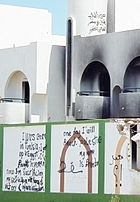
In late January, Jamal al-Hajji, a writer, political commentator and accountant, "call[ed] on the Internet for demonstrations to be held in support of greater freedoms in Libya" inspired by the Tunisian and Egyptian revolutions. He was arrested on 1 February by plain-clothes police officers, and charged on 3 February with injuring someone with his car. Amnesty International stated that because al-Hajji had previously been imprisoned for his non-violent political opinions, the real reason for the present arrest appeared to be his call for demonstrations. In early February, Gaddafi, on behalf of the Jamahiriya, met with political activists, journalists and media figures and warned them that they would be held responsible if they disturbed the peace or created chaos in Libya.
The protests would lead to an uprising and civil war, as part of the wider Arab Spring, which had already resulted in the ousting of long-term presidents of adjacent Tunisia and Egypt. Social media played a central role in organizing the opposition. A social media website declared an alternative government, one that would be an interim national council, was the first to compete with Muammar Gaddafi's political authority. Gaddafi's senior advisor attempted to reject the idea by tweeting his resignation.
Uprising and civil war
The protests, unrest and confrontations began in earnest on 2 February 2011. They were soon nicknamed the Libyan Revolution of Dignity by the protesters and foreign media. Foreign workers and disgruntled minorities protested in the main square of Zawiya, Libya against the local administration. This was succeeded by race riots, which were squashed by the police and pro-Gaddafi loyalists. On the evening of 15 February, between 500 and 600 demonstrators protested in front of Benghazi's police headquarters after the arrest of human rights lawyer Fathi Terbil. Crowds were armed with petrol bombs and threw stones. Marchers hurled Molotov cocktails in a downtown square in Benghazi, damaging cars, blocking roads, and hurling rocks. Police responded to crowds with tear gas, water cannon, and rubber bullets. 38 people were injured, including 10 security personnel. The novelist Idris Al-Mesmari was arrested hours after giving an interview with Al Jazeera about the police reaction to protests.
In a statement released after clashes in Benghazi, a Libyan official warned that the Government "will not allow a group of people to move around at night and play with the security of Libya". The statement added: "The clashes last night were between small groups of people – up to 150. Some outsiders infiltrated that group. They were trying to corrupt the local legal process which has long been in place. We will not permit that at all, and we call on Libyans to voice their issues through existing channels, even if it is to call for the downfall of the government."
On the night of 16 February in Bayda, Zawiya and Zintan, hundreds of protesters in each town calling for an end to the Gaddafi government set fire to police and security buildings.
A "Day of Rage" in Libya and by Libyans in exile was planned for 17 February. The National Conference for the Libyan Opposition asked that all groups opposed to the Gaddafi government protest on 17 February in memory of demonstrations in Benghazi five years earlier. The plans to protest were inspired by the Tunisian and Egyptian revolution. Protests took place in Benghazi, Ajdabiya, Derna, Zintan, and Bayda. Libyan security forces fired live ammunition into the armed protests. Protesters torched a number of government buildings, including a police station. In Tripoli, television and public radio stations had been sacked, and protesters set fire to security buildings, Revolutionary Committee offices, the interior ministry building, and the People's Hall.
On 18 February, police and army personnel later withdrew from Benghazi after being overwhelmed by protesters. Some army personnel also joined the protesters; they then seized the local radio station. In Bayda, unconfirmed reports indicated that the local police force and riot-control units had joined the protesters. On 19 February, witnesses in Libya reported helicopters firing into crowds of anti-government protesters. The army withdrew from the city of Bayda.
Cultural revolt
Rap, hip hop and traditional music, alongside other genres, played a big role in encouraging dissent against Gaddafi's government. Music has been controlled and dissenting cultural figures have been arrested in Arab Spring countries, including Libya. Music provided an important platform for communication among demonstrators. It helped to create moral support and encouraged a spirit of revolt against the governments.
An anonymous hip hop artist called Ibn Thabit gave a voice to "disenfranchised Libyans looking for a non-violent way to express their political will". On his website, Ibn Thabit said that he "has been attacking Gaddafi with his music since 2008" when he posted his first song on the internet, titled "Moammar – the coward". Lyrics of a song 'Al-Soo'al' released by Ibn Thabit on YouTube on 27 January 2011, weeks before the riots began in Libya were indicative of the rebel sentiment.
Some groups, such as a rock band from Benghazi called the "Guys Underground", used metaphors to cloak the censure of the authorities. The group released a song just before the uprising entitled "Like My Father Always Says" to ridicule an autocratic fictional male head of a family which was a veiled reference to Colonel Gaddafi.
Organization
Many opposition participants called for a return to the 1952 constitution and a transition to multi-party democracy. Military units who joined the rebellion and many volunteers formed fighting units to defend against Jamahiriya attacks and to work to bring Tripoli under the influence of Jalil. In Tobruk, volunteers turned a former headquarters of the government into a centre for helping protesters. Volunteers reportedly guarded the port, local banks and oil terminals to keep the oil flowing. Teachers and engineers set up a committee to collect weapons. Likewise, supply lines were run by volunteers. For example, in Misrata people organised a pizza service which delivered up to 8,000 pizzas a day to fighters.
The National Transitional Council (Arabic: المجلس الوطني الانتقالي) was established on 27 February to consolidate efforts for change in the rule of Libya. The main objectives of the group was to co-ordinate resistance between towns held in rebel control, and represent the opposition to the world, but did not include forming an interim government. The Benghazi-based opposition government had called for a no-fly zone and airstrikes against the Jamahiriya. The council began to refer to itself as the Libyan Republic and by March had a website. Former Jamahiriya Justice Minister Mustafa Abdul Jalil said in February that the new government would prepare for elections and they could be held in three months. On 29 March, the political and international affairs committee of the Council presented its eight-point plan for Libya in The Guardian newspaper, stating they would hold free and fair elections and draft a national constitution.
An independent newspaper called Libya appeared in Benghazi, as well as rebel-controlled radio stations. Some of the rebels opposed tribalism and wore vests bearing slogans such as "No to tribalism, no to factionalism".
Composition of rebel forces
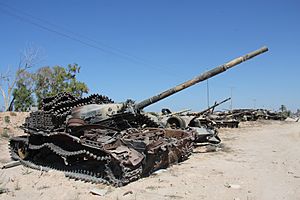
The rebels primarily included civilians, such as teachers, students, lawyers, and oil workers, but also defected police officers and professional soldiers. Many Islamists were part of the rebel movement in both eastern and western Libya. Rebel groups primarily initiated from Misrati, Zentan and Derna. In Benghazi "the February 17 Brigade" was a powerful Islamist group composed of 12 different brigades. The Libya Shield was based out of Mistrata and Zaria. There was also the Libyan Islamic Fighting Group and the Obaida Ibn Jarrah Brigade which has been held responsible for the assassination of top rebel commander General Abdul Fatah Younis.
Gaddafi's administration repeatedly asserted that the rebels included al-Qaeda fighters. Rebels denied this. NATO's Supreme Allied Commander James G. Stavridis stated that intelligence reports suggested there were "flickers" of al-Qaeda activity among rebels, but that there was insufficient information to confirm a significant presence of terrorist groups. Gaddafi's claims are supported by a 2008 secret cable from the US embassy in Tripoli to the US State Department, and an analysis by the Combating Terrorism Center at the US Military Academy at West Point of a set of documents called the Sinjar Records, purporting to show a statistical study of the al-Qaeda personnel records. The West Point analysis of these documents concluded that Libya provided "far more" foreign fighters in per capita terms than any other country. A disclosed file from 2005 on WikiLeaks found that rebel leader Abu Sufian Ibrahim Ahmed Hamuda Bin Qumu was a former Guantanamo Bay detainee alleged to be a member of the Libyan Islamic Fighting Group, to have joined the Taliban in 1998, and that he was a "probable member of Al Qaida and a member of the African Extremist Network".
Domestic responses
Resignation of government officials
In response to the use of force against protesters, a number of senior Libyan public officials either renounced the Gaddafi government or resigned from their positions. Justice Minister Mustafa Abdul Jalil and Interior Minister Major General Abdul Fatah Younis both defected to the opposition. Oil Minister Shukri Ghanem and Foreign Minister Moussa Koussa fled Libya, with the latter defecting to the UK. Libyan Prosecutor General Abdul-Rahman al-Abbar resigned from the post and joined the opposition.
The staff of a number of diplomatic missions of Libya have either resigned or condemned the actions of the Gaddafi government. The ambassadors to the Arab League, European Union and United Nations have either resigned or stated that they no longer support the government. The ambassadors to Australia, Bangladesh, Belgium, France, India, Indonesia, Malaysia, Nigeria, Portugal, Sweden, and the US also renounced the Gaddafi government or formally resigned.
Military defections
A number of senior military officials defected to the opposition, including General Abdul Fatah Younis, General al-Barani Ashkal, Major General Suleiman Mahmoud, Brigadier General Musa'ed Ghaidan Al Mansouri, Brigadier General Hassan Ibrahim Al Qarawi and Brigadier General Dawood Issa Al Qafsi. Two Libyan Air Force colonels each flew their Mirage F1 fighter jets to Malta and requested asylum, after being ordered to carry out airstrikes against civilian protesters in Benghazi. Colonel Nuretin Hurala, the commander of the Benghazi Naval Base also defected along with senior naval officials.
Libyan royal family
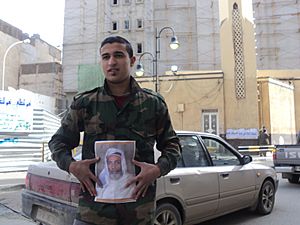
Muhammad as-Senussi, son of the former Crown Prince and grand-nephew of the late King Idris, sent his condolences "for the heroes who have laid down their lives, killed by the brutal forces of Gaddafi" and called on the international community "to halt all support for the dictator with immediate effect."
On 24 February, as-Senussi gave an interview to Al Jazeera where he called upon the international community to help remove Gaddafi from power and stop the ongoing "massacre". He dismissed talk of a civil war saying "The Libyan people and the tribes have proven they are united". He asked for a no-fly zone over Libya but does not support foreign ground troops. On 20 April, Mohammed spoke in front of the European Parliament calling for more support for Libya. He also stated that he will support any form of government that Libya will choose after Gaddafi including a constitutional monarchy.
A rival claimant to the throne, Idris bin Abdullah al-Senussi, announced in an interview with Adnkronos that he was ready to return to Libya and "assume leadership" once change had been initiated. On 21 February, he made an appearance on Piers Morgan Tonight to discuss the uprising. In March, it was reported Idris bin Abdullah had held meetings at the State Department and Congress in Washington with US government officials. It was also reported attempts at contact had been initiated by French and Saudi officials. On 3 March, it was reported that another member of the family, Prince Zouber al-Senussi, had fled Libya with his family and was seeking asylum in Totebo, Sweden.
Course of the war
First weeks
By 23 February, Gaddafi was suffering from the resignations and defections of close allies, from the loss of Benghazi, the fall of Tobruk, Misrata, Bayda, Zawiya, Zuwara, Sabratha, Sorman, and mounting international isolation and pressure. By the end of February, Gaddafi's government had lost control of a significant part of Libya, including the major cities of Misrata and Benghazi, and the important harbours at Ra's Lanuf and Brega. But in early March, Gaddafi's forces pushed the rebels back and eventually reached Benghazi and Misrata. On 10 March, the president of the ICRC Jakob Kellenberger warned of the increase in the intensity of fighting and in the number of casualties arriving at hospitals in Ajdabiya and Misrata.
By 11 March, the Libyan Air Force was running out of quality jet fuel, and the government tried to bribe Maltese Air Force officials in order to buy fuel.
Foreign military intervention
The Royal Canadian Navy frigate HMCS Charlottetown was deployed to the Mediterranean off the coast of Libya on 2 March 2011, but did not take immediate action once arrived. Seventeen days later, a multi-state coalition began a military intervention in Libya to implement United Nations Security Council Resolution 1973, which was taken in response to events then occurring during the conflict. That same day, military operations began, with US forces and one British submarine firing cruise missiles. the Royal Canadian Air Force, French Air Force, United States Air Force, and British Royal Air Force undertaking sorties across Libya and a naval blockade by the Royal Navy.
From the beginning of the intervention, the coalition of Belgium, Canada, Denmark, France, Italy, Norway, Qatar, Spain, UK and US expanded to 17 states. Newer states mostly enforced the no-fly zone and naval blockade or provided military logistical assistance. The effort was initially largely led by the United States. NATO took control of the arms embargo on 23 March, named Operation Unified Protector. An attempt to unify the military command of the air campaign (while keeping political and strategic control with a small group), first failed due to objections by the French, German, and Turkish governments. On 24 March, NATO agreed to take control of the no-fly zone, while command of targeting ground units remained with coalition forces.
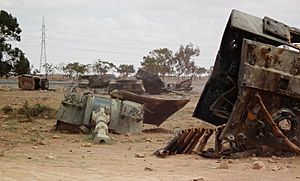
In May 2011, when Gaddafi's forces were still fighting, and the result of the civil war was still uncertain, Putin and Dmitri Medvedev's Russian government recognized the National Transitional Council (NTC) of Libya as a legitimate dialogue partner. On 9 June 2011, some negotiators from NTC arrived in Beijing to have negotiations with the Chinese government.
In June 2011, Muammar Gaddafi and his son Saif al-Islam announced that they were willing to hold elections and that Gaddafi would step aside if he lost. Saif al-Islam stated that the elections could be held within three months and transparency would be guaranteed through international observers. NATO and the rebels rejected the offer, and NATO soon resumed bombardment of Tripoli.
In July 2011, Saif al-Islam accused NATO of bombing Libyan civilians, including his family members and their children, under the false pretence that their homes were military bases. He also stated that NATO offered to drop the ICC charges against him and his father if they accept a secret deal, an offer they rejected. He thus criticized the ICC as "a fake court" that is controlled by the NATO nations.
A book by the UN's top man on the ground in Libya during the anti-Gaddafi uprising, Ian Martin, revealed that NATO's' deployments of special forces were "deliberately concealed" from the UN Security Council. Also, NATO failed to investigate civilian deaths from its bombing campaign and gave "unconvincing" arguments for promoting regime change in the name of protecting civilians. Martin writes "Nato operations had increasingly extended from preventing attacks by Gaddafi's forces to supporting rebel advances."
20 August rebel offensive
Heads of the rebellion reported on 21 August that Gaddafi's son, Saif al-Islam, was under arrest and that they had encircled the leader's compound, suggesting that the war had reached its endgame with an imminent rebel victory. By 22 August, rebel fighters had gained entrance into Tripoli and occupied Green Square, which was promptly renamed Martyrs' Square in memory of those who had died fighting in the civil war. Early on 23 August, Saif al-Islam appeared at the Gaddafi-controlled Rixos Hotel in central Tripoli and boasted his father was still in control. Later the same day, rebels blasted open the Bab al-Azizia compound in Tripoli through its north gates and stormed inside. Despite previous reports suggesting that Muammar Gaddafi may be inside, no members of the Gaddafi family were found.
Early the following day, 24 August, Gaddafi broadcast an address from a Tripoli local radio station in which he said the withdrawal from Bab al-Azizia had been a "tactical" move. The New York Times reported rebel leaders as saying they believed the only areas still under Gaddafi's control, other than the immediate neighbourhood of Bab al-Azizia, were al-Hadhba and Abu Salim, the latter including the Rixos Hotel where a group of foreign journalists had been trapped for days. However, the report noted the rebels lacked a unified command and that Gaddafi loyalists and snipers remained at large in many areas of Tripoli. Local hospitals and clinics, even in areas considered under rebel control, were reporting hundreds of cases of gunshot wounds and the death toll was impossible to estimate. By late afternoon the journalists trapped at the Rixos Hotel had been released while heavy fighting continued in the Abu Salim region close to Bab al-Azizia and elsewhere. The rebels were reported as estimating 400 people had been killed and a further 2,000 injured in the battle.
After Tripoli and NTC victory
Efforts to mop up pro-Gaddafi forces in northwestern Libya and toward Sirte began even before the rebels fully consolidated control of Tripoli. Rebels took the city of Ghadames near the borders of Tunisia and Algeria on 29 August. Members of the Gaddafi family took flight to Algeria. In September, the Gaddafi stronghold of Bani Walid was besieged by rebels, who reported that Gaddafi's son Saif al-Islam was hiding in the city. On 22 September, the NTC captured the southern city of Sabha, and claimed to have found a large cache of chemical weapons. Concerns were raised over the danger of Gaddafi mounting an insurgency against the new authorities.
By mid-October 2011, much of the city of Sirte had been taken by NTC forces, although fierce fighting continued around the city center, where many pro-Gaddafi fighters were encamped. The NTC captured the whole of Sirte on 20 October 2011. There were also reports of harassment and theft by rebels; however, the rebel army indicated it would leave unarmed civilians "to their own devices", and had allowed families in the city access to supplies and medical assistance.
On 1 September, when Gaddafi lost his capital Tripoli but continued fighting, the Russian government under president Dmitry Medvedev and prime minister Vladimir Putin recognized the Libyan NTC as the only legal regime in Libya. On 5 September, Libyan NTC spokesman, Abdulrahman Busin, said the NTC has hard evidence that Gaddafi bought arms from China. Chinese Foreign Ministry spokeswoman Jiang Yu has confirmed arms sales talks with Gaddafi forces, but no arms were delivered. On 12 September, Hu Jintao and Wen Jiabao's People's Republic of China government also recognized the NTC of Libya as the only Legal regime in Libya. When China and Russia had abandoned their support of Gaddafi, a spokesman of the NTC of Libya said because of their long time support of Gaddafi, it will be very hard for a Chinese, Russian or Indian oil companies to acquire new exploration contracts.
Aftermath
Despite the defeat of Gaddafi's loyalists, the capture of his last cities and Gaddafi's death, Saif al-Islam, Gaddafi's son and successor, remained hiding in the southern region of Libya until his capture in mid-November. In addition, some loyalist forces crossed into Niger.
Sporadic clashes between NTC and former loyalists also continued across Libya with low intensity. Fighting broke out on 3 January 2012, at a building used as intelligence headquarters by the Gaddafi government. Abdul Jalil, the chairman of NTC, warned Libyans that the country could descend into another civil war if they resort to force to settle their differences.
Also on 3 January, Libya's government named a retired general from Misrata, Yousel al-Manquosh, as head of the country's armed forces.
Bani Walid was captured by local tribal fighters on 23 January, due to the NTC's perceived inability to cooperate with them. The local forces were said to have used heavy weapons and numbered 100–150 men. Eight NTC fighters were killed and at least 25 wounded, with the rest fleeing the city. Clashes were also reported in Benghazi and Tripoli.
The NTC has functioned as an interim legislature during the transitional period. In early May 2012, it passed its most sweeping measures to date, granting immunity to former rebel fighters for acts committed during the civil war and ordering that all detainees accused of fighting for Gaddafi should be tried or released by 12 July 2012. It also adopted Law 37, prohibiting the publication of "propaganda" criticising the revolution, questioning the authority of Libya's governing organs, or praising Muammar Gaddafi, his family, his government, or the ideas of the Green Book.
A September 2013 report by The Independent shows that Libya had plunged into its worst political and economic crisis since the defeat of Gaddafi. The production of oil had almost completely stopped and the government had lost control of large areas of the country to the militias, while violence increased throughout the country. By May 2014, conflicts between several factions in Libya had descended into a second civil war.
Impact
Casualties
Independent numbers of dead and injured in the conflict have still not been made available. Estimates have been widely varied. On 24 February, Libya's ambassador to Malta said that Gaddafi's government believed the number of dead to be about 300, including civilians, police officers, and soldiers. The exact same day, the Islamic Republic of Iran Broadcasting reported that the International Criminal Court estimated 10,000 had been killed. The numbers of injured were estimated to be around 4,000 by 22 February.
On 2 March, the World Health Organization estimated approximately 2,000 killed. At the same time, the opposition said that 6,500 people had died. Later, rebel spokesman Abdul Hafiz Ghoga reported that the death toll reached 8,000.
In June 2011, Amnesty International stated that earlier estimates of the initial clashes in February were exaggerated. It estimated that during the first few days of the conflict, 100 to 110 people were killed in Benghazi and 59 to 64 were killed in Bayda.
Legal qualification
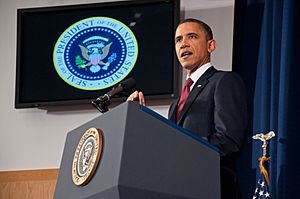
Legal qualification of an armed conflict determines which rules of international humanitarian law apply to the conduct of the parties during that conflict. In general, the normative framework applicable to international conflicts is broader and more detailed than the sum of rules that apply in conflicts not of an international character.
The qualification of the Libyan conflict is the subject of some academic controversy. While most agree that the intensity of the fighting and the organization of the insurgents quickly rose to the level required for the existence of a non-international armed conflict under Common Article 3 of the 1949 Geneva Conventions, the exact date when these conditions were considered fulfilled ranges from late February to 10 March 2011.
It is generally accepted that the military intervention by a multi-state coalition acting under the Security Council mandate since 19 March 2011 occasioned an international armed conflict between Libya and the intervening states. Some academics believe that this intervention transformed the legal nature of the conflict as a whole, with the result that even the rebels should have been considered one of the parties to an overarching international conflict spanning the whole Libyan territory. Others doubt this on account of both legal and factual considerations.
Finally, it remains unsettled whether or not the rebels' overthrow of Gaddafi's government following the fall of Tripoli in August 2011 changed the nature of the conflict again. Some academics believe that as the rebels were now the legitimate and effective government of the state of Libya, the conflict was "deinternationalised" and thus non-international in nature again. Others maintain the opposite position, arguing that the available legal tests for "deinternationalisation" are unpersuasive and introduce vague and politicized criteria that cannot be satisfactorily considered in the heat of the battle. Consequently, these authors would consider that the international nature of the conflict remained unchanged until the end of hostilities.
The ongoing conflict (or conflicts) ended for the purposes of legal qualification with the conclusion of hostilities in Libya in the end of October 2011.
Ethnic targeting
In August 2011, the UNHCR issued a strong call for the rights and lives of sub-Saharan Africans living in Libya to be protected due to reports that black Africans were being targeted by the rebel forces as cities fell. Other news sources including The Independent and CNN have reported on the targeting of black people in rebel held areas.
An Amnesty International statement, released on 30 August 2011, stated that on visits to detention centres in Zawiya and Tripoli, Amnesty International was informed that between one third and half of those detained were from Sub-Saharan Africa. A New York Times online article also comments that "it seems that plenty of the black Africans captured as mercenaries were never actually involved in the fight". "Hundreds of thousands of sub-Saharan Africans worked in Gaddafi's Libya, doing everything from managing hotels to sweeping floors. But some also fought as pro-Gaddafi mercenaries, and many migrant workers [-] fled ahead of the rebels, fearing they would be mistaken for mercenaries."
The town of Tawergha, which supported Gaddafi prior to its capture by anti-Gaddafi fighters in August, has been emptied of its mostly black inhabitants in what appeared to be a "major reprisal against supporters of the Gaddafi regime", according to an 11 September report from The Sunday Telegraph, and commanders of the Misrata Brigade are refusing to allow the displaced townspeople to return. One commander was quoted as saying, "Tawergha no longer exists."
In 2014 a former Gaddafi officer reported to the New York Times that the civil war was now an "ethnic struggle" between Arab tribes (like the Zintanis) against those of Turkish ancestry (like the Misuratis), as well as against the Berbers and Circassians.
Libyan refugees
Fleeing the violence of Tripoli by road, as many as 4,000 refugees were crossing the Libya–Tunisia border daily during the first days of the uprising. Among those, escaping the violence, were native Libyans as well as foreign nationals including Egyptians, Tunisians and Turks. In February, Italian Foreign Minister Frattini expressed his concerns that the amount of Libyan refugees trying to reach Italy might reach between 200,000 and 300,000 people. By 1 March, officials from the UN High Commissioner for Refugees had confirmed allegations of discrimination against sub-Saharan Africans who were held in dangerous conditions in the no-man's-land between Tunisia and Libya. By 3 March, an estimated 200,000 refugees had fled Libya to either Tunisia or Egypt. A provisional refugee camp set up at Ras Ajdir with a capacity for 10,000 was overflowing with an estimated 20,000 to 30,000 refugees. Many tens of thousands were still trapped on the Libyan side of the frontier. By 3 March, the situation was described as a logistical nightmare, with the World Health Organization warning of the risk of epidemics.
To continue responding to the needs of people staying at the Ras Ajdir crossing point in Tunisia, the WFP and Secours Islamique-France were upgrading a kitchen that would provide breakfast for families. Separately, the ICRC advised it was handing over its operations at the Choucha Camp to the Tunisian Red Crescent. Since 24 March, the WFP supplied over 42,500 cooked meals for TCNs at the Saloum border. A total of 1,650 cartons of fortified date bars (equivalent of 13.2 metric tons) had also been provided to supplement these meals.
The Sunday Telegraph reported on 11 September that almost the entire population of Tawergha, a town of about 10,000 people, had been forced to flee their homes by anti-Gaddafi fighters after their takeover of the settlement. The report suggested that Tawergha, which was dominated by black Libyans, may have been the subject of ethnic cleansing provoked by a combination of racism and bitterness on the part of Misratan fighters over the town's support for Gaddafi during the siege of Misrata.
Economic, religious and tribal
Oil prices around the world increased during the Libyan conflict, due to the country's significant oil reserves. The Arabian Gulf Oil Company, the second-largest state-owned oil company in Libya, announced plans to use oil funds to support anti-Gaddafi forces. Islamic leaders and clerics in Libya, notably the Network of Free Ulema – Libya urged all Muslims to rebel against Gaddafi. The Magarha tribe announced their support of the protesters. The Zuwayya tribe, based in eastern Libya, threatened to cut off oil exports from fields in its part of Libya if Libyan security forces continued attacking demonstrators.
The Tuareg people consistently supported Gaddafi during the Civil War, and for a time sheltered Gaddafi's son, Saif al-Islam. It is worth noting that Gaddafi had given many Tuareg refuge from persecution in neighbouring Sahel countries, and that he patronized Tuareg culture in many ways, such as through festivals such as the Ghadames Festival, and also the designation of Ghadames old town as a UNESCO World Heritage Site. One Tuareg fighter said he and other Tuareg were ready to "fight for Gaddafi to the last drop of blood".
Tuareg areas such as Ghat remain Gaddafi loyalist strongholds to this day.
See also
 In Spanish: Guerra de Libia de 2011 para niños
In Spanish: Guerra de Libia de 2011 para niños
- 1976 Libyan protests
- 2011 Battle of Tripoli
- 2011 Battle of Sirte
- Aftermath of the First Libyan Civil War
- Arab Spring
- Free speech in the media during the 2011 Libyan Civil War
- Moussa Ibrahim, Gaddafi's spokesman
- Human rights in Libya
- List of modern conflicts in North Africa
- List of modern conflicts in the Middle East
- Green Resistance
- 2015 European migrant crisis


